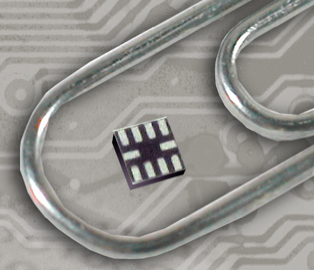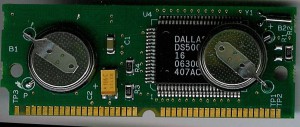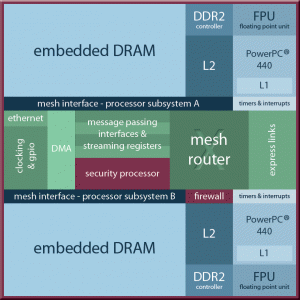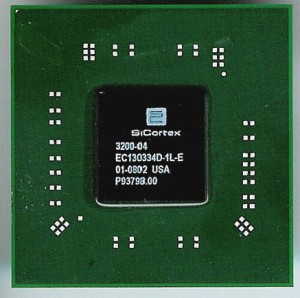June 12th, 2009 ~ by admin
Space can often be at a premium, especially in embedded design. The original 8051 microcontroller was about 750 sq mm. SiLabs new one? yah all of 4mm^2, and has more features, and is faster. It includes I2C and UARTs integrated in hardware, and an onboard 24.5MHz oscillator.

Silicon Labs C8051T606
Source: EE Times
May 26th, 2009 ~ by admin
Sony recently released their touchscreen walkman, which is a pretty slick device. Sony Insider dissected one and what is absent, is about as interesting as what is there. Sony use to be a pretty big manufacturer of in house IC designs, everything from DSP,s to processors (like the Cell used in the PS3) to analog parts. So in this new walkman you would expect to see the Sony name on at least one or 2 parts. The main processor is a NEC ARM chip, RAM by Hynix, and Flash by Samsung so all said a pretty much off the shelf build.
May 10th, 2009 ~ by admin
Most companies saw dismal results in the 1Q of ’09. April however has seens a few rises. Both TSMC, and UMC saw increased sales, partly due to the Chinese stimulus package, and likely due in part to the release of the Kindle 2. Is it economic downturn over? Not likely, but at least there has been some shining lights amongst it.
May 1st, 2009 ~ by admin
There has been rumors flying a lot lately about Microsoft possibly making a version of Windows 7 available to run on ARM based processors. Intel obviously is very much against this happening, which is why it NEEDS to happen. The current CPU market is starting to get stale. Intel has around 80% marketshare, and AMD is struggling to compete. This does not lead to innovation on the scale we saw back in the 90’s when there were several processor companies making Windows compatible chips.
Currently the #1 processor for mobile devices is ARM (in its many flavors), It powers the iPhone, the Palm Pre, many Blackberries and hundreds of others. ARM processors run OS X, Android, PalmOS, and Windows Mobile (as well as Windows CE). We now are seeing growth in a new segment, Netbooks, and soon to be tablets. There are several of these that are ARM based and run flavors of linux, but the vast majority use Intel Atom CPU’s and run Windows XP.
ARM processors, clock for clock, are more powerful, and more efficient then the Intel Atom. Windows 7 running on ARM processors would open up vast new oppurtunities in the netbook/MID class of devices both in software, and hardware. And perhaps more importantly it would force both AMD,and Intel to compete with better and more innovative products. Intel would need to shift some of its focus away from AMD, and into competing with ARM, allowing AMD to grow as well. ARM licensing scheme would also allow us to break away from the choke hold that Intel currently holds on the x86 style architecture.
The end result? More speed, features, and efficiency for the consumer, and a much more stable processor industry.
April 22nd, 2009 ~ by admin
Amazon’s Kindle 2 e-book has been a pretty big success. What many do not know is the amount of processing power in it. The main processor is a Freescale MCIMX31LVKN5C Applications processor, which is based on a 532MHz ARM11 core (yes it is faster then an iPhone). The Wireless connectivity is provided by a Qualcomm MSM6801A baseband processor, which at its heart is a 200MHz ARM9 core. Also included in it is 2GB of Samsung moviNAND which is flash memory, with the controller (itself a processor) built in. The electrophoretic bistable display uses a controller made by E-ink and Epson, which of course contains a microcontroller.
In modern electronics the question is not “Does it have a processor?”, but rather “How many processor cores does it have?”
April 12th, 2009 ~ by admin
Performing your banking with an unsecured connection, or surfing the web without a anti-virus is dangerous to say the best. Your data may become compromised which of course could serious ruin your day. These problems extend to the hardware level as well. In such things as your microwave, their is software running on the hardware to control it. It would be possible to extract this software code given the right tools. Stealing kitchen appliance code is not a particular threat obviously. However, there ARE applications where the software running on a set of hardware IS very important, more so often then the hardware itself. Take for example the battlefield management software on a tank, or the flight control system on a F-22A Raptor. This is not something you want someone to be able to recover.

Dallas Maxim DS2252T-128-16
Several companies make what are called ‘Secure Processors.’ These are processors designed to keep the code on them VERY secure. Above is one from Maxim, tamper with it, and the SRAM is auto erased to all 0’s rendering the code useless. It has encrypted data buses, on-board AES encryption, random key generators, the works.

CPU Technology CPU872 Acalis
A Company called CPU Tech has a processor called the CPU872, which is now available for commercial use (previous designs have been DoD only). Programs are securely booted from encrypted flash and decrypted onto on-chip embedded DRAM, and neither cleartext nor the decryption key is ever accessible, according to CPU Tech. In a multi-processor system, all I/O communication between CPU872 devices is also secured, according to the firm. This processor includes 8MB of onboard DRAM, as well as a pair of 800MHz PowerPC 440 cores. The security however doesn’t start at the chip; CPU Tech only uses ‘Trusted Foundaries’ in the manufacture of their parts, to ensure malicious hardware is not added to the part during fabbing.
April 4th, 2009 ~ by admin
SiCortex is a supercomputer company, or as they are called today ‘High Performance Computers’ (HPCs). HPCs have traditionally taken vast amounts of room, and vast amounts of power. SiCortex has changed that. Their fastest offers 5,832 1.4GFlops 64-bit processors, each dissipating just 900 milliwatts of power. All interprocessor communications logic plus two DDR-2 memory controllers and PCI Express I/O logic are on the same node chip with the multiple processor cores. Complete with its 8 Terabytes of system memory, the SC5832 fits in a single cabinet and only requires around 20 kilowatts of wall power.

SiCortex Node chip
These nodes, shown above, each contain 6 MIPS64 cores running at 700MHz, a pair of DDR2 memory controllers, gigabit ethernet, an 8xPCI Express controller, and 256k of L2 Cache, quite impressive.
Much thanks to SiCortex for donating this node chip to the museum.
April 1st, 2009 ~ by admin
Most mobile electronics runs on around 3V. For example your cell phone typically used a 3.7V Li Ion battery. For some applications this much battery is not wanted, or feasible. A single AA battery produces 1.2-1.5Volts, but as it is used this voltage will drop. Atmel has just released a new line of their Tiny AVR (RISC microcontrollers that can run at voltages down to 0.7V. Internally they are a 3V design, but they include a boost converter that can boost voltages from 0.7V to 1.8V to the 3V needed by the core, as well as the 4k of flash and 64bytes of on-board EEPROM.

ATtiny43u
All of this, in a 20 pin package running at up to 8MHz and costing a mere $1. This is why there is a microcontroller in almost every piece of electronics.
April 1st, 2009 ~ by admin
Freescale is beginning to turn out new embedded processors on a 45nm process. The same process size Intel uses to make the Corei7 CPU’s Freescale is using to make 6 PowerPC cored devices for the communications market. With speeds of up to 1.3GHz at only a few watts the performance is rather good.
The target market is 3G and 4G cellular base stations.
Source: EE Times
March 2nd, 2009 ~ by admin
Intel, made their long anticipated announcement today. Much speculation floated last week as to what they were to announce. Today they announced a partnership with TSMC in manufacturing the Atom CPU core. Intel is hoping to take on the likes of ARM, and XAP, and other licensed cores by doing so. TSMC excels in integrating third party designs and will do so with the Atom, the idea being to build custom ASICS’s and SoC’s around the Intel Atom core. This MAY be a boon to Intel, allowing them to finally break into the mobile devices (phones etc) in a much broader way then the old PXA line that they sold to Marvell.
Source: Forbes






